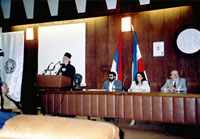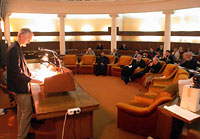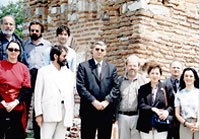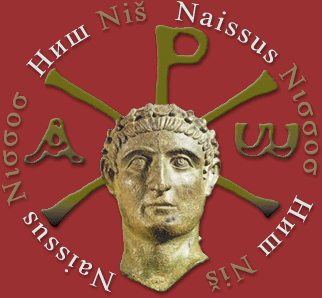

"NIŠ AND BYZANTIUM ART"
First International Symposium
Niš, 03-05 June 2002
 The City of Nis, within the celebration of the Day of St.Emperor Constantine and Empress Helen, organized for the first time an international scientific symposium on the theme "NIS AND BYZANTIUM ART". The Symposium was held at the Nis University Hall. In the lobby, in front of the Hall, in cooperation with the National Museum, there was set up an exibition of the copies of the Early Christian tomb frescoes from Jagodin Mala, which are iretrrievably lost nowadays. The meeting was blessed by Mr. Irinej, the Bishop of Nis. The participants were welcomed by the Mayor, Mr. Goran Ciric, and the meeting was opened by academician Dejan Medakovic, the president of the Serbian Academy of sciences and arts. According to the determined scedule, the papers were presented within the morning and afternoon sessions, on the first and the second day, while the last day was reserved for the reception at the City Hall and the visit tour of the monuments of Nis and its surroundings.
The City of Nis, within the celebration of the Day of St.Emperor Constantine and Empress Helen, organized for the first time an international scientific symposium on the theme "NIS AND BYZANTIUM ART". The Symposium was held at the Nis University Hall. In the lobby, in front of the Hall, in cooperation with the National Museum, there was set up an exibition of the copies of the Early Christian tomb frescoes from Jagodin Mala, which are iretrrievably lost nowadays. The meeting was blessed by Mr. Irinej, the Bishop of Nis. The participants were welcomed by the Mayor, Mr. Goran Ciric, and the meeting was opened by academician Dejan Medakovic, the president of the Serbian Academy of sciences and arts. According to the determined scedule, the papers were presented within the morning and afternoon sessions, on the first and the second day, while the last day was reserved for the reception at the City Hall and the visit tour of the monuments of Nis and its surroundings.
In the conception of this symposium, the basis was the fact that the medieval past of Nis is insufficiently known. Incomplete researches, even of the well known constructions, could be most precisely and very likely explained by unintrest, and not only by the lack of the material means. That is how came up a defeating level of cognition of the Christian past of Nis which, in respect to politics, economy, religion, culture and art used to have an important role in the Byzantine Empire whose heritage was firmly incorporated in the foundations of the European civilization and art. Neither the fact that St. Emperor Constantine was born in Nis, to whom the Christian part of the world owns that what it is today, was an enough reason to pay deserved attention to him. On the other side, even those monuments that are well known are inappropiately protected and maintained. For that reason, considering that the historical and art inheritance of Nis is inseparable from the European culture and art, we iniciated the organization of the international scientific symposium on the theme "Nis and Byzantium".
The idea of the organizers is to gather together the eminent researches who deal with the Byzantium and Postbyzantium Art History, as well as the outstanding scientists of the research fields without whose knowledge it would be impossible to perceive in entirety the art and historical inheritance of Nis. That implied the presence of art historians, historians, archeologists, clasical philologists, theologists, theoreticians of the medieval literature, philosophy and estetics.
The intention of the organizers of the Symposium, which would be concentrated around the Early-Christian, Byzantine and Post-Byzantine cultural heritage, as well as the reflection of the Byzantine Art heritage on the latter art creativity of Nis and Nisavlje, is to comprehend through the scientific arguments its position in the cultural mosaic of Europe. Gathering of reputable European, and particularly Balkan scientists and targeting their knowledge to the area of our city would contribute to the illumination of many question marks related to the Early-Christian and Byzantine past of Niš and its region. The real picture of the city of Niš can only be created on the grounds of knowledge about our rich Christian past, which has been relegated to a marginal status in scientific research during the last 50 years. The task of the Symposium is to divert the attention of the European scholarly public to the significance of Niš for the entire Christian world.
 From the prof. Dejan Medakovic presentation we could overlook the importance of the art and historian heritage of Nis, the necessity of its revelation and studying within the Byzantium world and modern historical moment. He considers that the theme of the symposium is well chosen because it includes all forms of political and spiritual life not only of the city but of the whole Nis region. Prof. Medakovic's paper contains the ideas that will serve to the organizer as the guidelines for organization of the symposium which should grow into regular gathering on the Day of St.Emperor Constantine and Empress Helena.
From the prof. Dejan Medakovic presentation we could overlook the importance of the art and historian heritage of Nis, the necessity of its revelation and studying within the Byzantium world and modern historical moment. He considers that the theme of the symposium is well chosen because it includes all forms of political and spiritual life not only of the city but of the whole Nis region. Prof. Medakovic's paper contains the ideas that will serve to the organizer as the guidelines for organization of the symposium which should grow into regular gathering on the Day of St.Emperor Constantine and Empress Helena.
Dr Aleksandar Loma (Beograd), once again iniciated the issue about the origin of the name of Nis and the Nisava. Beginning from the assumption that the antique name of Nis -*Navisko-, springs from the old name of the Nisava - Navya, contained in the name of the vilage in its upper confluence Nevlja (earlier Navlja), the author explores the question of the language origin and the genuine meaning of that name.
The paper of Mr. Vladimir Cvetkovic (Nis), reveals the spititual climate that dominated in the region of Gornja Mezija in the period of the third and fourth decade of IV century , with the particular respect to the important details of the sojourn of St. Athanasiju the Great in Nis and this region. The archeological researches results of the area of the south west part of the under city Justiniana Prima (Empress' city), were presented by dr Bernard Bavant and dr Vujadin Ivanisevic (Strasbourg- Beograd). The revealed remains of fortifications with towers and the gate, porticus and street, parts of aquaduct and complexes of the housing and craft buildings were presented. After this exposure the chronology of the city development and urban development, the look of the buildings and material culture of pleobyzantine period at the area of north Ilirica are more clearly reviewed.
Jasminka Nikolic (Skoplje) revealed to us an engraved cross (XVII century) from the private collection and established its connection with the similar crosses from Athos.
Mr. Branko Gorgiev (Nis) drew the attention to some implications of the meeting of Fridrih I Barbarosa and Stefan Nemanja. Just from one intersection of the extract of the Dizberts's and Ditpold's work, the participnts in negotiations between Fridrih and Nemanja, the situation of international, political, military, religious and cultural relations in Europe at the end of XII century.
Mirjana Masnic (Skopje) introduced to us so far unknown village church Vavedenje Bogorodicino in Zadunje, while Mr. Radomir Petrovic (Beograd), through the iconographic analysis of so far unknown icon "St. Dimitrius on the hors kills the Bulgarian Emperor Kolojan and saves Thesaloniki" established its realtion with the known in the Serbian art.
Karmen Angela Baban (Romania) spoke about the conversion of Constantine the Great, and from two opposite attitudes about Constantine's egsegeze offered the anex to the real Constantine's conversion backing up that standing by imperial massages issued after year 313.
Dr Radmilo Petrovic (Beograd) indicated the importance of the imperial mint in Nis, from where the works of importance for the whole Roman Empire came out.
Mr. Oliver Tomic (Beograd) began his presentation with the analysis of the famous personality of the emperor Constantine the Great from Nis, with the intention to show how much the scenes of the Roman eperors of the tetrarchy age and IV century are the real reflection of their true look, and by that, over the review of the painted characteristics and by the thorough analysis of the datails enlight the ruler's opinion about himself.
Dr Sladjana Ristic-Gorgiev (Nis) delt with the concept of beauty in the Byzantine philosphy and how it is comprehended by the Holy Fathers. The political and poetical nature of ''The hagiography of St. Simeon" by Stefan Prvovencani was revealed by Dr Dragisa Bojovic (Pristina).
Dr Aleksandar Jovanovic's paper (Beograd), consists of 3 archeological notesthet reveal a direct connection between Constantine the Graet with Naisa: the first is related to the urban-administrative aspects, the second to the segmrnts of the strategical fortification Naisa, and the third to the reflection of the art of the Constantine's epoch in Naisus.
Draginja Maskareli (Beograd) delt with the project of arch. Jovan Ilkic that is not realized regarding the Eparchy house building in Nis and Ilkic's contribution in seeking of the national style in the new Serbian architecture.
Dealing with the architecture of Nis Cathedral Dr Aleksandar Kadijevic indicated its period lamination, which, at this moment when some restauration is prepared, is of great importance.
Misa Rakocija (Nis) introduced to the symposium recenly reviewd architectonic forms of the church St. Jovan in Orljane village and its role in the history of the Bizantine architecture. By this occasion the issue about the Byzantine town Komplos known from the charter of the Emperor Vasilije II was opened again.
Nebojsa Ozimic (Nis) drew the historical, political and biographical paralels between two great early Byzantine rulers - Constantine I and Justiniane I.
Unfortunately, some of the colleagues who applied for the participations with the interesting works, couldnt attend the symposium due to the justified reasons: Branka Ivanic (Beograd) - "Mara Brankovic and the art monuments of south Serbia"; dr Ivanka Gergova ( Sofija) - "About the authors of the icons at the church St. Archangels in Nis"; Aneta Serafimova (Skoplje) - "Establishing of the sent icons and rising of the wholy cross in the post Byzantine Art"; Ioanis Sisiou (Kastoria) - "Moving of the artists from Kostur towards the North"; Mr. Milorad Lazic (Beograd) - "Byzantine esthetic values in the Serbian medieval culture".
 For consolation, these works will be also printed in the symposium Proceedings. The participants were provided with the videobim and the projector for their presentation. There was especially interesting discusion before each break, during which, beside the opinion exchange among the colleagues, there was the opportunity for the visitors and the admirers of our cultural heritage to rise questions to the experts. Here should be mentioned also the delight of the participants for the hospitality expressed by the organizers.
For consolation, these works will be also printed in the symposium Proceedings. The participants were provided with the videobim and the projector for their presentation. There was especially interesting discusion before each break, during which, beside the opinion exchange among the colleagues, there was the opportunity for the visitors and the admirers of our cultural heritage to rise questions to the experts. Here should be mentioned also the delight of the participants for the hospitality expressed by the organizers.
The intention of the symposium organizers is that the gathering of our eminent researchers grow into the regular one, on the Day of St. Emperor Constantine and empress Helen. The participants' papers will be printed in the luxury provided Proceedings, with whose promotion the symposium will be started every next year.
Miša Rakocija
Translated by Ana Mišić, coordinator

![]()


